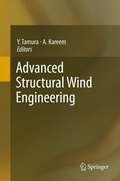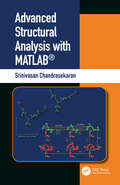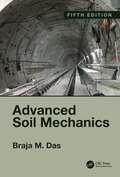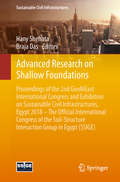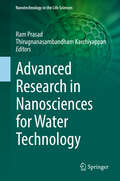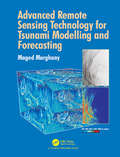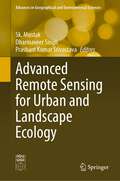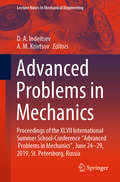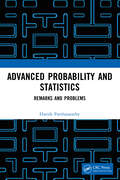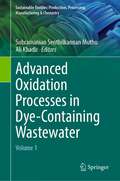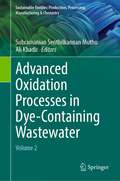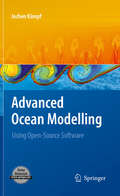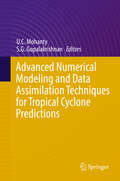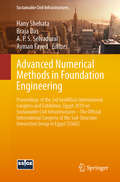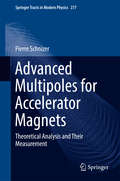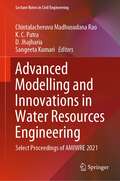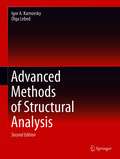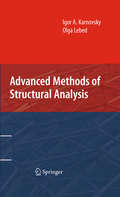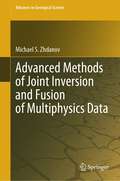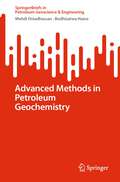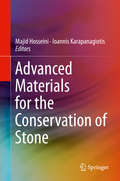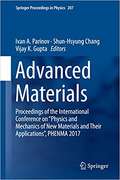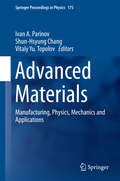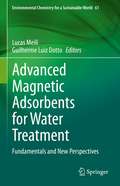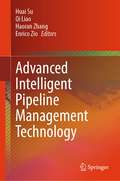- Table View
- List View
Advanced Structural Wind Engineering
by Yukio Tamura Ahsan KareemThis book serves as a textbook for advanced courses as it introduces state-of-the-art information and the latest research results on diverse problems in the structural wind engineering field. The topics include wind climates, design wind speed estimation, bluff body aerodynamics and applications, wind-induced building responses, wind, gust factor approach, wind loads on components and cladding, debris impacts, wind loading codes and standards, computational tools and computational fluid dynamics techniques, habitability to building vibrations, damping in buildings, and suppression of wind-induced vibrations. Graduate students and expert engineers will find the book especially interesting and relevant to their research and work.
Advanced Structural Analysis with MATLAB®
by Srinivasan ChandrasekaranRecent advancements in the selection of various geometric structural forms demand understanding of structural analysis using computer-aided tools. This book presents various important aspects of computer-aided tools and programming for advanced structural analysis, and includes exercises, exams with solutions, and MATLAB input-output code to provide a complete understanding of concepts. The content has been well received by graduate students and faculty colleagues. Demand from the students for a full-length textbook motivated the author to develop the present book, which follows a classroom model of explaining the concepts through clear explanations, illustrations, and tutorials.
Advanced Soil Mechanics, Fifth Edition
by Braja M. DasNow in its fifth edition, this classic textbook continues to offer a well-tailored resource for beginning graduate students in geotechnical engineering. Further developing the basic concepts from undergraduate study, it provides a solid foundation for advanced study. This new edition addresses a variety of recent advances in the field and each section is updated. Braja Das particularly expands the content on consolidation, shear strength of soils, and both elastic and consolidation settlements of shallow foundations to accommodate modern developments. New material includes: Recently published correlations of maximum dry density and optimum moisture content of compaction Recent methods for determination of preconsolidation pressure A new correlation for recompression index Different approaches to estimating the degree of consolidation A discussion on the relevance of laboratory strength tests to field conditions Several new example problems This text can be followed by advanced courses dedicated to topics such as mechanical and chemical stabilization of soils, geo-environmental engineering, critical state soil mechanics, geosynthetics, rock mechanics, and earthquake engineering. It can also be used as a reference by practical consultants.
Advanced Research on Shallow Foundations: Proceedings Of The 2nd Geomeast International Congress And Exhibition On Sustainable Civil Infrastructures, Egypt 2018 - The Official International Congress Of The Soil-structure Interaction Group In Egypt (ssige) (Sustainable Civil Infrastructures)
by Hany Shehata Braja DasThis volume deals with the advanced analysis of shallow foundations. Several research studies are considered including soil plasticity, cracking, reaching the soil bearing capacity, creep, etc. Dynamic analyses together with stability analysis are also discussed. It gives wide range of topics dealing with the shallow foundations in different parts of the world. The volume is based on the best contributions to the 2nd GeoMEast International Congress and Exhibition on Sustainable Civil Infrastructures, Egypt 2018 – The official international congress of the Soil-Structure Interaction Group in Egypt (SSIGE).
Advanced Research in Nanosciences for Water Technology (Nanotechnology in the Life Sciences)
by Ram Prasad Thirugnanasambandham KarchiyappanThe establishment of clean, safe water is one of the major challenges facing societies around the globe. The continued urbanization of human populations, the increasing manipulation of natural resources, and the resulting pollution are driving remarkable burden on water resources. Increasing demands for food, energy, and natural resources are expected to continue to accelerate in the near future in response to the demands of these changing human populations. In addition, the complexity of human activities is leading to a diversity of new chemical contaminants in the environment that represent a major concern for water managers. This will create increased pressure on both water quantity and quality, making it increasingly difficult to provide a sustainable supply of water for human welfare and activities. Although protection of water resources is the best long-term solution, we will also need innovative novel approaches and technologies to water treatment to ensure an adequate superior quality resource to meet these needs. Solving tomorrow’s water issues will require unique approaches that incorporate emerging new technologies. Great advances have been made in the area of nanotechnology. Due to their unique physical and chemical properties, nanomaterials are extensively used in antibacterial medical products, membrane filters, electronics, catalysts, and biosensors. Nanoparticles can have distinctly different properties from their bulk counterparts, creating the opportunity for new materials with a diversity of applications. Recent developments related to water treatment include the potential use of carbon nanotubes, nanocompositae, nanospheres, nanofibers, and nanowires for the removal of a diversity of chemical pollutants. By exploiting the assets and structure of these new materials, such as increased surface area, high reactivity, and photocatalytic action, it will be possible to create technologies that can be very efficient at removing and degrading environmental pollutants. Understanding and using these unique properties should lead to innovative, cost-effective applications for addressing the complexities of emerging needs for water treatment and protection. Although still in the early stages, research into the application of nanotechnology shows great promise for solving some of these major global water issues. This comprehensive text describes the latest research and application methods in this rapidly advancing field.
Advanced Remote Sensing Technology for Tsunami Modelling and Forecasting
by Maged MarghanyThe innovation in space technologies has generated a new method for observing and monitoring tsunamis from space. Most tsunami remote sensing studies focus on using classical image processing tools or conventional edge detection procedures. However, these methods do not use modern physics, applied mathematics, signal communication, remote sensing data and innovative space technologies. This book equips readers to understand how to monitor tsunamis from space with remote sensing technology art to create a better alarm warning system.
Advanced Remote Sensing for Urban and Landscape Ecology (Advances in Geographical and Environmental Sciences)
by Sk. Mustak Dharmaveer Singh Prashant Kumar SrivastavaThis book introduces the use of various remote sensing data such as microwave, hyperspectral and very high-resolution (VHR) satellite imagery; mapping techniques including pixel and object-based machine learning; and geostatistical modelling techniques including cellular automation, entropy and land fragmentation. Remote sensing plays a vital role in solving urban and environmental challenges at the landscape level. Globally, more than half of the urban population is facing severe environmental and social challenges, especially those relating to climate change, agricultural land encroachment, green infrastructure and environmental degradation, mobility due to rapid rural–urban transformation and anthropogenic interventions. Mapping and quantification of such threats at the landscape level are challenging for experts using traditional techniques; however, remote sensing technology provides diverse spatial data at a varying scale, volume and accessibility for mapping and modelling, and it also analyses challenges at urban and landscape levels. Together, they address challenges at urban and landscape levels to support the Sustainable Development Goals (SDGs).
Advanced Problems in Mechanics: Proceedings of the XLVII International Summer School-Conference “Advanced Problems in Mechanics”, June 24-29, 2019, St. Petersburg, Russia (Lecture Notes in Mechanical Engineering)
by D. A. Indeitsev A. M. KrivtsovThis book focuses on original theories and approaches in the field of mechanics. It reports on both theoretical and applied research, with a special emphasis on problems and solutions at the interfaces of mechanics and other research areas. The respective chapters highlight cutting-edge works fostering development in fields such as micro- and nanomechanics, material science, physics of solid states, molecular physics, astrophysics, and many others. Special attention has been given to outstanding research conducted by young scientists from all over the world. Based on the 47th edition of the international conference “Advanced Problems in Mechanics”, held on June 24–29, 2019, in St. Petersburg, Russia, and organized by Peter the Great St. Petersburg Polytechnic University and Institute for Problems in Mechanical Engineering of Russian Academy of Sciences under the patronage of Russian Academy of Sciences, the book provides researchers and graduate students with an extensive overview of the latest research and a source of inspiration for future developments in various fields of mechanics.
Advanced Probability and Statistics: Remarks and Problems
by Harish ParthasarathyThe chapters in this book deal with: Basic formulation of waveguide cavity resonator equations especially when the cross sections of the guides and resonators have arbitrary shapes. The focus is on expressing the total field energy within such a cavity resonator as a quadratic form in the complex coefficients that determine the modal expansions of the electromagnetic field. The reviews of basic statistical signal processing covering linear models, fast algorithms for estimating the parameters in such linear models, applications of group representation theory to image processing problems especially the representations of the permutation groups and induced representation theory applied to image processing problems involving the three dimensional Euclidean motion group. The Hartree-Fock equations for approximately solving the two electron atomic problem taking spin-orbit magnetic field interactions into account has been discussed. In the limit as the lattice tends to a continuum, the convergence of the stochastic differential equations governing interacting particles on the lattice to a hydrodynamic scaling limit. It will be useful to undergraduate and postgraduate students with courses on transmission lines and waveguides, and statistical signal processing. Print edition not for sale in South Asia (India, Sri Lanka, Nepal, Bangladesh, Pakistan or Bhutan).
Advanced Oxidation Processes in Dye-Containing Wastewater: Volume 1 (Sustainable Textiles: Production, Processing, Manufacturing & Chemistry)
by Subramanian Senthilkannan Muthu Ali KhadirAmong various industries releasing wastewater into the environment, printing, dyeing and textile industries are of great importance as they frequently contain high amounts of colorful compounds having high chemical and biological oxygen demands. Health related effects of colorants are extensively reported; which necessitates the seriousness of dye removal from water and wastewater. The utilization of advanced oxidation processes (AOPs) in dye degradation has gained considerable attention recently due to the release of high energetic radicals as oxidants that are capable of removing dye compounds. This Volume 1 presents versatile applications of AOPs in dye removal. Accordingly, processes such as Ozone-based AOPs, UV irradiation, catalytic AOPs, etc are discussed with the aim of dye removal under different operational parameters. The role of different nanoparticles is also investigated. By presenting the fundamentals of AOPs as well as recent advances, this book is useful for environmental engineers and chemists who are concerned with wastewater pollution and treatment.
Advanced Oxidation Processes in Dye-Containing Wastewater: Volume 2 (Sustainable Textiles: Production, Processing, Manufacturing & Chemistry)
by Subramanian Senthilkannan Muthu Ali KhadirTextile industry wastewater contains toxic dyes as well as heavy metals and many other persistent organic compounds which are difficult to biodegrade using conventional biological methods. Advanced Oxidation Processes (AOPs) are one of the best alternatives for the effective degradation of such compounds. This Volume 2 starts with homogeneous and heterogeneous Fenton processes and reviews the application and variables that affect the process. It then discusses plasma technology- an emerging method in terms of its chemistry, treatment set-up, limitations, etc. The positive performance of carbon tetrachloride in process intensification of dye degradation is presented. The other chapters include topics such as sonoenzymatic treatment processes, electroflocculation versus textile wastewater, combination of photocatalysis and membrane Separation, and enhancement of anaerobic digestion and photodegradation through adsorption.
Advanced Ocean Modelling: Using Open-Source Software
by Jochen KämpfThis book introduces the reader to advanced methods used in the computer-based modelling of fluid processes. This includes nonhydrostatic processes such as breaking internal waves and density-driven convection, but the model code is also used to simulate an El-Niño event! The book contains 25 practical exercises, using freely available Open-Source software suites, which are widely used by the scientific community. In this book, the art of hydrodynamic modelling is made available and transparent to a wider readership. An attractive byproduct of the book is that results are animations rather than still images. Model codes and animation scripts for all exercises are supplied on a website. The reader can adopt model codes for own independent studies
Advanced Numerical Modeling and Data Assimilation Techniques for Tropical Cyclone Prediction
by U. C. Mohanty Sundararaman G. GopalakrishnanThis book deals primarily with monitoring, prediction and understanding of Tropical Cyclones (TCs). It was envisioned to serve as a teaching and reference resource at universities and academic institutions for researchers and post-graduate students. It has been designed to provide a broad outlook on recent advances in observations, assimilation and modeling of TCs with detailed and advanced information on genesis, intensification, movement and storm surge prediction. Specifically, it focuses on (i) state-of-the-art observations for advancing TC research, (ii) advances in numerical weather prediction for TCs, (iii) advanced assimilation and vortex initialization techniques, (iv) ocean coupling, (v) current capabilities to predict TCs, and (vi) advanced research in physical and dynamical processes in TCs. The chapters in the book are authored by leading international experts from academic, research and operational environments. The book is also expected to stimulate critical thinking for cyclone forecasters and researchers, managers, policy makers, and graduate and post-graduate students to carry out future research in the field of TCs.
Advanced Numerical Methods in Foundation Engineering: Proceedings of the 3rd GeoMEast International Congress and Exhibition, Egypt 2019 on Sustainable Civil Infrastructures – The Official International Congress of the Soil-Structure Interaction Group in Egypt (SSIGE) (Sustainable Civil Infrastructures)
by Hany Shehata Braja Das A. P. S. Selvadurai Ayman FayedThis book deals with the advanced analysis of the shallow foundations. Several research studies are considered including soil plasticity, cracking, reaching the soil bearing capacity, and creep. Dynamic analyses together with stability analysis are also included. It gives a wide range of dealing with the shallow foundations in different parts of the world.
Advanced Multipoles for Accelerator Magnets: Theoretical Analysis and Their Measurement (Springer Tracts in Modern Physics #277)
by Pierre SchnizerThis monograph presents research on the transversal beam dynamics of accelerators and evaluates and describes the respective magnetic field homogeneity. The widely used cylindrical circular multipoles have disadvantages for elliptical apertures or curved trajectories, and the book also introduces new types of advanced multipole magnets, detailing their application, as well as the numerical data and measurements obtained. The research presented here provides more precise descriptions of the field and better estimates of the beam dynamics. Moreover, the effects of field inhomogeneity can be estimated with higher precision than before. These findings are further elaborated to demonstrate their usefulness for real magnets and accelerator set ups, showing their advantages over cylindrical circular multipoles. The research findings are complemented with data obtained from the new superconducting beam guiding magnet models (SIS100) for the FAIR (Facility for Antiproton and Ion Research) project. Lastly, the book offers a comprehensive survey of error propagation in multipole measurements and an appendix with Mathematica scripts to calculate advanced magnetic coil designs.
Advanced Modelling and Innovations in Water Resources Engineering: Select Proceedings of AMIWRE 2021 (Lecture Notes in Civil Engineering #176)
by Chintalacheruvu Madhusudana Rao K. C. Patra D. Jhajharia Sangeeta KumariThis book presents select proceedings of the national conference on Advanced Modelling and Innovations in Water Resources Engineering (AMIWRE 2021) and examines numerous advancements in the field of water resources engineering and management towards sustainable development of environment. The topics covered includes river basin planning and development, reservoir planning and management, integrated water management, reservoir sedimentation, soil erosion and sedimentation, agricultural technologies for climate change mitigation, uncertainty analysis in hydrology, water distribution networks, floods and droughts management, water quality modelling, environmental modelling, environmental impact assessment, urban water management, open channel hydraulics, hydraulic structures, groundwater hydraulics, groundwater flow and contaminant transport modelling, computational fluid dynamics, ocean engineering, HEC-RAC, SWAT, MIKE, MODFLOW models applications, numerical analysis in water resources engineering, climate change impacts on hydrology, optimization techniques in water resources, soft computing techniques and applications in water resources and remote sensing / geospatial techniques in water resources. This book will be beneficial for water sectors development mainly agricultural production, reservoir operations, improvement of water quality, flood and drought controls, designing hydraulic structures and geospatial analysis. This book will be a valuable reference for faculties, research scholars, students, design engineers, industrialists, R & D personnel and practitioners working in water resources engineering and its related fields.
Advanced Methods of Structural Analysis
by Igor A. Karnovsky Olga LebedThis revised and significantly expanded edition contains a rigorous examination of key concepts, new chapters and discussions within existing chapters, and added reference materials in the appendix, while retaining its classroom-tested approach to helping readers navigate through the deep ideas, vast collection of the fundamental methods of structural analysis. The authors show how to undertake the numerous analytical methods used in structural analysis by focusing on the principal concepts, detailed procedures and results, as well as taking into account the advantages and disadvantages of each method and sphere of their effective application. The end result is a guide to mastering the many intricacies of the range of methods of structural analysis. The book differentiates itself by focusing on extended analysis of beams, plane and spatial trusses, frames, arches, cables and combined structures; extensive application of influence lines for analysis of structures; simple and effective procedures for computation of deflections; introduction to plastic analysis, stability, and free and forced vibration analysis, as well as some special topics. Ten years ago, Professor Igor A. Karnovsky and Olga Lebed crafted a must-read book. Now fully updated, expanded, and titled Advanced Methods of Structural Analysis (Strength, Stability, Vibration), the book is ideal for instructors, civil and structural engineers, as well as researches and graduate and post graduate students with an interest in perfecting structural analysis.
Advanced Methods of Structural Analysis
by Olga Lebed Igor A. KarnovskyAdvanced Methods of Structural Analysis aims to help its readers navigate through the vast field of structural analysis. The book aims to help its readers master the numerous methods used in structural analysis by focusing on the principal concepts, as well as the advantages and disadvantages of each method. The end result is a guide to mastering the many intricacies of the plethora of methods of structural analysis. The book differentiates itself from other volumes in the field by focusing on the following: * Extended analysis of beams, trusses, frames, arches and cables * Extensive application of influence lines for analysis of structures * Simple and effective procedures for computation of deflections * Introduction to plastic analysis, stability, and free vibration analysis Authors Igor A. Karnovsky and Olga Lebed have crafted a must-read book for civil and structural engineers, as well as researches and students with an interest in perfecting structural analysis. Advanced Methods of Structural Analysis also offers numerous example problems, accompanied by detailed solutions and discussion of the results.
Advanced Methods of Joint Inversion and Fusion of Multiphysics Data (Advances in Geological Science)
by Michael S. ZhdanovDifferent physical or geophysical methods provide information about distinctive physical properties of the objects, e.g., rock formations and mineralization. In many cases, this information is mutually complementary, which makes it natural for consideration in a joint inversion of the multiphysics data. Inversion of the observed data for a particular experiment is subject to considerable uncertainty and ambiguity. One productive approach to reducing uncertainty is to invert several types of data jointly. Nonuniqueness can also be reduced by incorporating additional information derived from available a priori knowledge about the target to reduce the search space for the solution. This additional information can be incorporated in the form of a joint inversion of multiphysics data.Generally established joint inversion methods, however, are inadequate for incorporating typical physical or geological complexity. For example, analytic, empirical, or statistical correlations between different physical properties may exist for only part of the model, and their specific form may be unknown. Features or structures that are present in the data of one physical method may not be present in the data generated by another physical method or may not be equally resolvable.This book presents and illustrates several advanced, new approaches to joint inversion and data fusion, which do not require a priori knowledge of specific empirical or statistical relationships between the different model parameters or their attributes. These approaches include the following novel methods, among others: 1) the Gramian method, which enforces the correlation between different parameters; 2) joint total variation functional or joint focusing stabilizers, e.g., minimum support and minimum gradient support constraints; 3) data fusion employing a joint minimum entropy stabilizer, which yields the simplest multiphysics solution that fits the multi-modal data. In addition, the book describes the principles of using artificial intelligence (AI) in solving multiphysics inverse problems. The book also presents in detail both the mathematical principles of these advanced approaches to joint inversion of multiphysics data and successful case histories of regional-scale and deposit-scale geophysical studies to illustrate their indicated advantages.
Advanced Methods in Petroleum Geochemistry (SpringerBriefs in Petroleum Geoscience & Engineering)
by Mehdi Ostadhassan Bodhisatwa HazraThis brief presents recent developments and new methodologies in the area of petroleum geochemistry, including innovative unconventional analytical methods such as Raman, NMR and XPS spectroscopy that are based on advanced analytical chemistry and recently developed instrumentation. It discusses delineating mechanisms for petroleum generation, expulsion, migration and accumulation in reservoirs from the source rock. This brief provides data, illustrations and detailed explanation of each method discussed, as well as data collection, interpretation of the results and intercorrelated characteristics of different case studies from a variety of samples. Geologists, engineers, and graduate students interested in the petroleum industry will all find the book valuable.
Advanced Materials for the Conservation of Stone
by Majid Hosseini Ioannis KarapanagiotisThis book identifies novel advanced materials that can be utilized as protective agents for the preservation of stone. The innovative solutions to stone conservation presented here result in increased sustainability, reduced environmental impact, and increased social and economic benefits. It provides an overview of recent trends and progress in advanced materials applied to stone protection. It also explores the scientific principles behind these advanced materials and discusses their applications to diff erent types of stone preservation efforts. Essential information as well as knowledge on the availability and applicability of advanced nanostructured materials is also provided, with focus placed on the practical aspects of stone protection. Th e book highlights an interdisciplinary eff ort regarding novel applications of nanostructured materials in the advancement of stone protection. It provides insight towards forthcoming developments in the fi eld. Advanced nanostructured materials are designed and developed with the aim of being chemically, physically, and mechanically compatible with stone. Advanced materials for stone conservation that are characterized by several functional properties are considered in this book. These include the physico-chemical, protective, and morphological properties, eco-toxicity, and mechanisms of degradation. The authors present a thorough overview of cutting-edge discoveries, detailed information on recent technological developments, breakthroughs in novel nanomaterials, utilization strategies for applications in cultural heritage, and the current status and future outlook of the topic to address a wide range of scientific communities.
Advanced Materials: Proceedings Of The International Conference On Physics And Mechanics Of New Materials And Their Applications , PHENMA 2017 (Springer Proceedings In Physics #207)
by Shun-Hsyung Chang Ivan A. Parinov Vijay K. GuptaProvides a consistent and original presentation of fabrication techniques, physics, mechanics, and applications of advanced materials and composites.<p><p> Helps readers to better understand modern R&D requirements for prospective materials and composites.<p> Features original theoretical, experimental and modeling results on novel materials and devices.<p> This book presents selected peer-reviewed contributions from the 2017 International Conference on “Physics and Mechanics of New Materials and Their Applications”, PHENMA 2017 (Jabalpur, India, 14–16 October, 2017), which is devoted to processing techniques, physics, mechanics, and applications of advanced materials. The book focuses on a wide spectrum of nanostructures, ferroelectric crystals, materials and composites as well as promising materials with special properties. It presents nanotechnology approaches, modern environmentally friendly piezoelectric and ferromagnetic techniques and physical and mechanical studies of the structural and physical–mechanical properties of materials. Various original mathematical and numerical methods are applied to the solution of different technological, mechanical and physical problems that are interesting from theoretical, modeling and experimental points of view. Further, the book highlights novel devices with high accuracy, longevity and extended capabilities to operate under wide temperature and pressure ranges and aggressive media, which show improved characteristics, thanks to the developed materials and composites, opening new possibilities for different physico-mechanical processes and phenomena
Advanced Materials: Manufacturing, Physics, Mechanics and Applications (Springer Proceedings in Physics #175)
by Vitaly Yu. Topolov Shun-Hsyung Chang Ivan A. ParinovAdvanced materials are the basis of modern science and technology. This proceedings volume presents a broad spectrum of studies of novel materials covering their processing techniques, physics, mechanics, and applications. The book is concentrated on nanostructures, ferroelectric crystals, materials and composites, materials for solar cells and also polymeric composites. Nanotechnology approaches, modern piezoelectric techniques and also latest achievements in materials science, condensed matter physics, mechanics of deformable solids and numerical methods are presented. Great attention is devoted to novel devices with high accuracy, longevity and extended possibilities to work in wide temperature and pressure ranges, aggressive media etc. The characteristics of materials and composites with improved properties opening new possibilities of various physical processes, in particular transmission and receipt of signals under water, are described.
Advanced Magnetic Adsorbents for Water Treatment: Fundamentals and New Perspectives (Environmental Chemistry for a Sustainable World #61)
by Lucas Meili Guilherme Luiz DottoThis book compiles 15 chapters about the synthesis, characterizations, and application of many kinds of magnetic adsorbents for water treatment. It is devoted to the scientific community that works with adsorption technologies for water treatment and remediation. Specifically, for professors and Ph.D. students. It is expected that this book serves as an interesting background for researchers in the field of magnetic adsorbents for water treatment.
Advanced Intelligent Pipeline Management Technology
by Huai Su Qi Liao Haoran Zhang Enrico ZioThis book summarizes the advanced intelligent pipeline management technologies. The text discusses the main challenges of how to define and reinvent data-driven intelligent pipeline systems by studying scheduling-operation- safety management systems. Additionally, within an all-around intelligent pipeline system technology development framework, this book characterizes the scientific problems of intelligent pipeline system services among different processes, such as scheduling, demand-side management, operation condition monitoring, safety analysis, fault detection, etc. This book also introduces the existing positive and successful intelligent pipeline system projects that can be identified in the studied domain, and how can they be best applied for practical success. The text is supported by informative illustrations and case studies so that practitioners can use the book as a toolbox to improve understanding in applying the novel technologies into intelligent pipeline system management and development.
